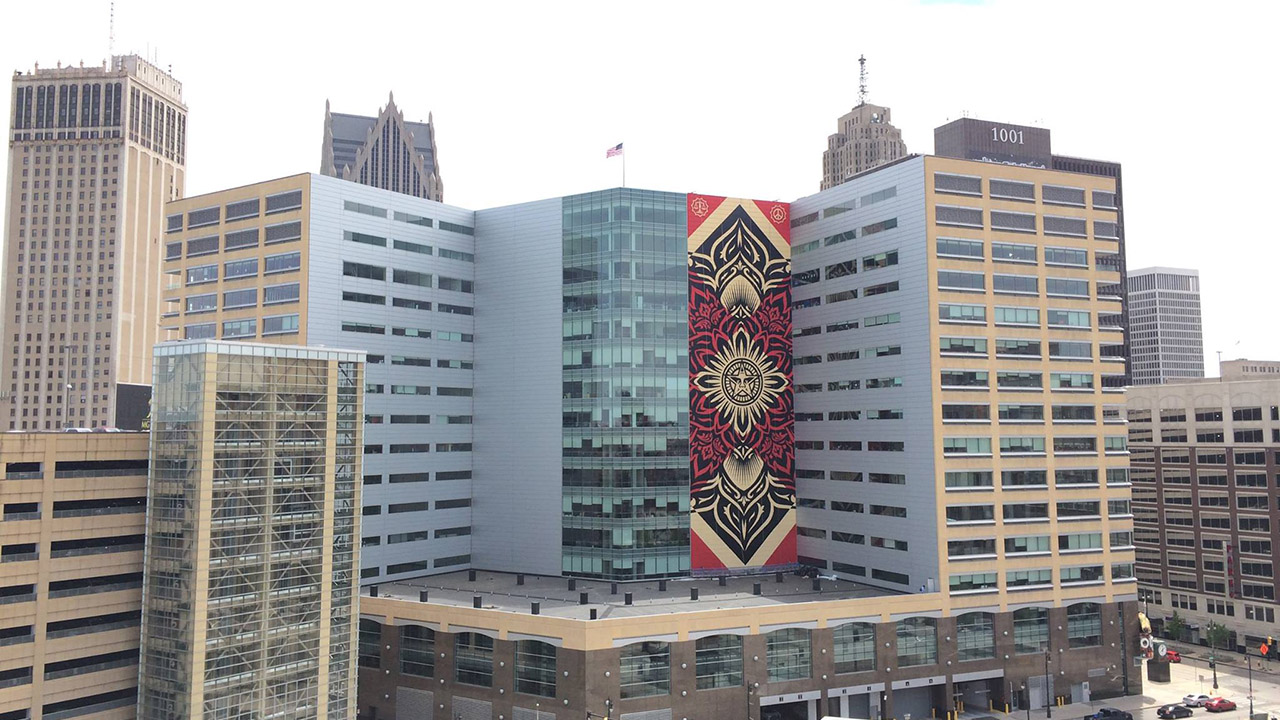Detroit, a city beset by serious crime, recently issued an arrest warrant for street artist Shepard Fairey. His crime? About nine pieces of paper that authorities claim he pasted up last month while he was in town painting the largest legal mural of his career.
In a May interview about the 18-story undertaking, he blatantly said that he’d also be doing illegal shit, too. “I still do stuff on the street without permission,” admitted Fairey to the paper. “I’ll be doing stuff on the street when I’m in Detroit.” Well, he kept his promise and is now being charged with two counts of malicious destruction of property, a felony that could result in jail time and hefty fines. Police began their investigation as soon as his signature work started popping up in the D.

The sanctioned work he did was commissioned as part of a partnership between Library Street Collective and mega-developer Dan Gilbert’s company Bedrock Real Estate Services, although Shepard says he spent his “own money” to make this project happnen. Some say it’s a great example of using art to attract young people, while for others, it’s just another way street art’s being used to soften the blow of gentrification. It’s an irony the world renowned graphic designer — who once counted President Barack Obama as one of his clients — doesn’t ignore. He embraces it. “I’m either accused of being a vandal or a gentrifier depending on who you ask,” wrote Fairey by email. “Realty has more nuance. I think art is a good thing in public spaces…for the most part.”
A spokesperson for Bedrock Real Estate Services refused to comment, which is probably a smart move since its founder, billionaire Dan Gilbert, hates illegal graffiti and street art.

Despite Fairey’s very public pledge to spread his work around the city without permission, Michigan defense attorney Jeffrey Buehner doesn’t think the case is going to be so easy for the police to prove. “They do have to be able to show that he’s the one who did it,” said the lawyer by phone. “It’s likely that these people didn’t see anything.” He also “doubts the damage level” the government is claiming, which amounts to a little over $9,000.
But how about the validity of the statute itself when it comes to an artist of Fairey’s stature? According to the wording of the law, prosecutors have to prove that Fairey acted to “willfully and maliciously destroy” a “person’s house, barn, or other building or its appurtenances.” Although his pilfered street works don’t fetch as much as Banksy’s, a very creative lawyer might argue that Fairey didn’t put up his valuable art with the intention of devaluing the property, but rather, the opposite. His work, after all, does have a set market value.
Gregg Pinto, a former Brooklyn prosecutor who opened his own practice, doesn’t think that argument is worth the risk, however. “Interesting theory, but I wouldn’t want to put it to a test considering the high fines and possible imprisonment,” said Pinto. The big problem with your theory is that the owners of the property didn’t authorize the work. If the owner decides that the property is damaged and has to make repairs, that’s considered to be damage to the property, regardless of whether it is aesthetically pleasing to the artist or anyone else.”
In published reports, police say that Fairey actually put up 14 of his signature wheat-pasted posters, but that they could only get nine of the property owners to press charges, which poses two questions: 1) Did the police tell them Fairey was a world famous artist? 2) Would they still press charges if they did?
Is Shepard Fairey tagging the D? http://t.co/KRSOyN3JVE #detroit pic.twitter.com/EfckyMrOS7
— Detroit News Now (@detroitnewsnow) May 23, 2015
ANIMAL’s in-house legal expert, The Law, says that artists like Banksy and Shepard Fairey defy the current vandalism statutes. “You wouldn’t even need to put him on the stand,” explains The Law. “Introduce evidence of how much his street art pieces go for on the open market. His works fetch thousands of dollars and are even in museums, including the Smithsonian. Of course the courts are not going to decide what is art, but there is a real question as to whether his intent could be considered malicious if he knows, and can document, that to his knowledge people whose buildings he installs art on, remove the artwork and sell it.”
Super lawyer Rob Kuby agrees. “There are proof problems in these kinds of cases in assessing the amount of injury to the properties,” said Kuby. “He may well have enhanced their value.”
(Photos: Obey Giant)



